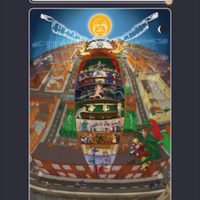There’s a scene in Book 2 of Alan Moore’s run on Swamp Thing—a comic series he wrote for near the beginning of his career—where a human woman and a plant-who-was-once-a-human-man make love. It isn’t sex in the way we generally perceive it. It’s something else, a pared down procreative process. As the human and the not-so-human spill into each other’s essences, Abigail, the woman, reflects, “The threadlights, a blazing cat’s cradle inside me, inside him… where we touch, the fibers merge and intertangle. I am no longer certain where I end… and where he begins.” What Moore is writing about here is transcendence.
Many of Moore’s most treasured characters, stories, and universes hinge on the idea of transcendence—of becoming something or someone greater, fuller, more. His famed Watchmen hero Dr. Manhattan, the nuclear scientist who was incinerated and later reborn in an almost divine form, struggles with the notion of mortal limits. Dr. Manhattan moralizes about and inquires into the boundaries of human existence, despite the fact that he himself is the very embodiment of that boundary-breaching, of Nietzsche’s ubermensch, the posthuman god. Dr. Manhattan is transcended, and he wonders how (and if) humanity can do the same. Sitting by himself on a planet in space, drifting with the solar winds, he muses on the miracle of being: “To distill so perfect a form from that chaos of improbability, like turning air to gold… that is the crowning unlikelihood.” In this singular moment, Moore gives a name to his fascination with attempting to depict transcendence: the “crowning unlikelihood.”
This idea of becoming, so pervading and so sublime for Moore, is also what William Blake evinces in his poem “Jerusalem,” the primary inspiration for Moore’s novel. In the course of the poem, Blake issues a rallying cry across England to kickstart the task of building “Jerusalem,/In Englands green & pleasant Land.” Blake calls for a seismic shift in England’s laboring population: he wants them to become builders not just of goods and services, but of “Divine Countenance” as well. As much as Blake’s poem imagines a major national movement, it also shows a smaller, personal transformation, one of individual fortitude and strength.
In his new novel Jerusalem, Alan Moore follows in Blake’s footsteps and calls for a general transcendence, arguing that the next leap in our human evolution is to become a kind of angel, and that we in the 21st century can achieve it.
By means of an astoundingly long, winding, in-depth, all-encompassing narrative, Jerusalem tells the story of Michael and Alma Warren, brother and sister, descendants of the famous Vernall family, known for madness and moments of religious fervor. One day at work, Michael suffers a painful injury and later experiences flashbacks to an incident he had as a three-year-old where he choked to death on a cough lozenge for a sore throat. These visions inspire Alma, a talented artist, to create her masterpiece: a totem-like portrait stacked with scene upon scene depicting life in Northampton. In some ways, Jerusalem reads like a bewitched Dickens novel, rife with family drama, secret histories, and seemingly irrelevant side-trips all cloaked in the Grand Master’s comic poeticism. It feels long and arduous at times, but the sheer entertaining value of the frenzied language keeps the momentum hurtling forward.
Like Blake, Moore focuses on ordinary working-class people, the people of Northampton, and he is no stranger to describing his hometown. His first novel took a similar journey through Northampton across several millennia, around different classes of characters in varying troubled circumstances. He performs the same portraiture work in Jerusalem. His profoundly colorful, diverse, haunted, and even melancholic portrait of the Boroughs—the sphere of impoverished citizens in Northampton—ought to make readers who live there burn with nostalgia and empathy. He examines the shame and madness of his neighbors through a lens of detail and honesty, weaving together a tribute neither admiring nor admonishing in its portraiture. Women dance to flutes at midnight in the streets, the customers of the Golden Lion regularly have dream-like prophetic visions during their drunken binges, and poets complain of their writer’s block to invisible sympathizers in the gutter.

Moore’s careful tracing of the long-incubating madness through generations of the Vernall family in Jerusalem is a feat of wondrous consistency—his wording is always precise, and even across hundreds of pages, the definitions, contexts, and lineages remain easy to grasp. There’s Ernest, who’s visited by angels while painting the top of a cathedral in the 1860s; there’s Snowy, having visions on the roof of an apartment building during the birth of his child in the early 1900s; and of course there’s poor little 3-year-old Michael, who chokes to death on a cough lozenge in 1959. Their encounters with angels, ghosts, and devils, (sometimes) confusingly induced by madness, thrusts them into contact with beings of greater dimension and knowledge. The Vernalls are, after all, keepers of the “verge,” according to Jerusalem.
Of the novel’s many themes, the most prominent are madness, ghosts, and the confusion of dreams, visions, memories, and premonitions. The world of Jerusalem swims in the feeling of “some great hurt too terrible to mend, or of some terrible betrayal,” wrought through time and busy neighborhood streets that are awash with phantoms. It’s a fine-tuned fantastical element that surges underneath the book’s surface, the sort of too-real-to-be-believable aura found in James Ellroy’s American Tabloid, James Joyce’s Ulysses, and T.H. White’s The Once and Future King.
So complete is Moore’s dedication to portraying every spooky, heartfelt, dirty detail of the Boroughs that it can seem like an exercise in Freud’s uncanny, like he’s actively creating the kind of city that can be explored, lost and afraid, in a dream. Jerusalem reminds us, as Freud would argue about the uncanny, that authors have a right to maintain an uncertainty about their subject by not letting us know, purposely, whether they are taking us into the real world or a fantastic one. As soon as apparitions and ghosts of madness appear in the town’s walkways and windows, Moore blankets their mystery in an almost Shakespearean way: he shows us that behind the “halfway houses with their portals that went nowhere,” behind the phantasmagoria, there is a “suggestive nothing.” Nothing, or emptiness, is the specter that haunts King Lear, just as it haunts Northampton in Jerusalem.
Of Jerusalem’s three epigrams—the novel is divided into three books, each with an epigram—the third, an excerpt from a letter Einstein wrote to a grieving friend, speaks most to this problem of reality: “the distinction between past, present, and future,” Einstein writes, “is only [a] stubbornly persistent illusion.” Are the ghosts in Northampton, then, part of a “past” that Moore is trying to conjure? Is there an afterlife, and if so, why does it seem to intersect with this old English town? Why does all this business about madness and visions and ghosts matter anyway?
The answer, in part, can be found with one of the book’s more interesting characters, an American living in Northampton, who, as an outsider of the community looking in, notices that “there [is] just something in the place, some kind of heart under the chimney smoke” that makes it like a “holy place.” That “something” about Northampton is what Jerusalem most seeks to convey—a strange and marvelous mythology, concurrent to our reality, filled with the dead and dreaming, a purgatorial waiting room called Mansoul.
Mansoul is the afterlife, an entire cosmos in its own right, and Moore has a field day describing the ins and outs of his bizarre ghost-colony. At the place’s capitol, Mayorhold, in a divine billiard hall, four gods called Builders play a game of pool to determine the trajectories of individual lives (manifested as pool balls). One of those lives—that of Michael Warren’s (the Warrens are related to the Vernalls)—is hit into the wrong pocket, a sacrilegious error that drags the Builders, and all of Mansoul, into utter disarray. To get his bearings, Michael joins the Dead Dead Gang, a group of dead children whose renowned adventures lead them through time and the afterlife, and together they investigate the collapse of spectral order.
Chapters involving the Dead Dead Gang are told with measured wit and a unique daydream-like whimsy that makes the idea of children exploring purgatory seem endearing. These chapters, buoyed largely by Moore’s shockingly strange and imaginative writing, make up the novel’s emotional core. The dead children—Reggie, Bill, Phyllis, John, Marjorie, and Michael—visit Oliver Cromwell on the eve of the Battle of Naseby, ward off a demon referenced in the Book of Tobit, wander around futuristic wastelands, and eat fairies prepared like biscuits. Every scene, every conversation and action is told in the sepia glow of latency, of missed opportunity—these are children romping through ghost towns infested with demons and inebriated souls.
Because of this, at the center of Jerusalem, haunting every page, there is a profound sense of what the Greeks call apóleia: a kind of irreversible loss. At the beginning of the novel, Alma Warren sees small, dirtied laborers working in the night, and they wear “robes… strong as cotton… with ice-blue shadows” in almost angelic fashion. This scene, like many in the novel, is strongly reminiscent of William Blake, particularly his poem “Chimney-Sweeper,” in which orphaned children labor in the dark to sweep the soot from chimneys. Although these feelings of loss, derived from the pain of stunted youth, can be tragic and heartbreaking, they return us to where we started—the idea of transcendence.
Loss is, as Einstein said, a sort of illusion. Missed opportunity, absence, and debt are all variations of nothing, and nothing, as we learned, can be suggestive. Moore has said it himself before, in perhaps the most enduring line he ever wrote: “‘In the end? Nothing ends, Adrian. Nothing ever ends.’” In Jerusalem, he proves that notion hundreds of times over. “There’s not a minute of ayr lives is ever lost,” one of the dead children says consolingly, “and all the pulled-dayn ‘ouses what we miss are ‘ere forever, in Mansoul.” The true impact of Jerusalem emerges from this strain of redemption, which reveals that all roads of loss—loss of money, family, friends, dreams—end in the place of our betters, where children, banded together from misery, watch over the rest of us like the angels we can become.
And so, here at the end of all things, after 600,000 words and 1,200 or so pages, Moore leaves us with a story, an epic that will surely join the ranks of England’s greatest works of literature. Imagine, if you will, yourself at the end of your life, looking back over the span of your days, dwelling in another unimaginable time and place and universe. There in the afterlife, in eternity, you recognize an old friend of yours from childhood playing with a group of kids—only, looking at the group closer now, you realize it’s not your friend, but someone who looks exactly like him: his son. Although your friend’s son can’t possibly know who you are, and although you feel heartache seeing the deceased child of a childhood comrade, you approach him and ask him if his dad ever spoke of an old chum. The child thinks for a moment, then tells you that, yes, his dad spoke of an older chum all the time. And there in the playground of that unknowable infinity, halfway between the world and the numberless dimensions beyond, a lost child reminds you of the love someone once had for you. And in life or death, says Jerusalem, that’s all that really matters: the love that never ends.




